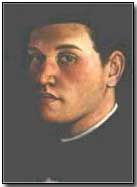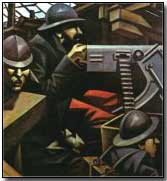Who's Who - Christopher Nevinson
 Christopher Richard Wynne
Nevinson (1889-1946) was a noted British war painter, whose predilection for
representing the mechanical nature of war set him apart from many of his
wartime contemporaries.
Christopher Richard Wynne
Nevinson (1889-1946) was a noted British war painter, whose predilection for
representing the mechanical nature of war set him apart from many of his
wartime contemporaries.
Nevinson was the son of the noted journalist journalist Henry Nevinson, and shared similarly radical views. A leading avant garde figure Nevinson opted to join the Red Cross as a dedicated pacifist upon the outbreak of war in 1914.
He subsequently served with the Royal Army Medical Corps (R.A.M.C.) in London but was invalided out of the army in January 1916 suffering from rheumatic fever. This was not however the end of his war. An exhibition of his paintings later that year in September brought him to the attention of the chief war propagandist Charles Masterman of the War Propaganda Bureau (WPB).
Masterman successfully petitioned Nevinson to travel to the Western Front painting in an official capacity for the British government. In spite of his known radicalism Nevinson eagerly accepted, and it is to Masterman's credit that Nevinson's work largely escaped censorship, although much of it would have appeared uncomfortable in official quarters.
 For Nevinson's work was
stark in drawing the public's attention to the increasingly mechanised
nature of modern warfare, far removed from the romantic artistry that often
accompanied the early stages of the war, which generally depicted man
fighting man (often in hand to hand combat). Machine Gun,
exhibited in 1916, is typical of his work in this respect.
For Nevinson's work was
stark in drawing the public's attention to the increasingly mechanised
nature of modern warfare, far removed from the romantic artistry that often
accompanied the early stages of the war, which generally depicted man
fighting man (often in hand to hand combat). Machine Gun,
exhibited in 1916, is typical of his work in this respect.
Nevinson made repeated visits to the front lines in drawing inspiration for his work. Those paintings that were regarded as unsuitable for publication during wartime were subsequently made available following the armistice. He was later to express dissatisfaction with his work for the War Propaganda Bureau even though it gave him a valuable outlet for his work: he fretted that he was being used for the opposite purpose he had in mind ("may it burn their lousy souls").
After the war Nevinson concentrated on townscape and genre painting. His autobiography, Paint and Prejudice, was published in 1937. He renewed his career as a war artist with the onset on the Second World War but a stroke cut short his war involvement in 1942. He died in 1946.
A 'corkscrew' was a metal post for supporting a wire entanglement, with a twisted base enabling it to be screwed into the ground, removing the need for a hammer, the use of which could attract enemy fire.
- Did you know?
